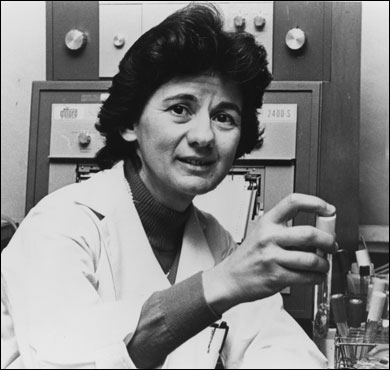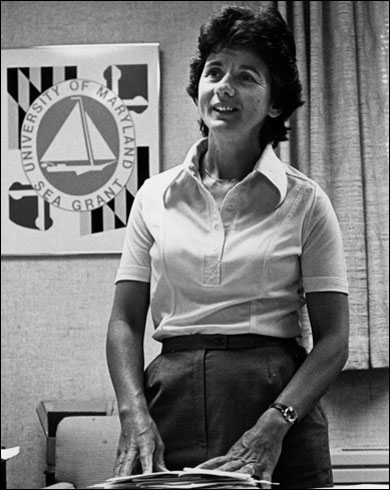Special 30th Anniversary Issue
The Bay around Us
|
|
|
Embracing Complexity
At the end of a long hallway that smells of fresh paint, Rita Colwell's office in the new center for Bioinformatics and Computational Biology at the University of Maryland is one of the only occupied offices on the floor. Most of her boxes are unpacked, save a few stacks of journal reprints. A bowl of fruit and miniature Oreos on the table in the middle of her office invite visitors to make themselves at home. Pictures of Colwell's children and grandchildren sit on a bookshelf under the window, next to a picture of herself with former president Bill Clinton. Diplomas and honorary degrees hang next to simple canvas artwork that looks like it was collected overseas. Three hard hats sit high on a shelf, souvenirs of various ground-breaking ceremonies — one from the University of Maryland Biotechnology Institute, where she served as founding director and president, one from the Christopher Columbus Center, which she helped create, and one from AAAS, where she served a term as president.
Colwell is at home in the new center, one dedicated to multidisciplinary research on questions arising from the genome revolution, a revolution in scientific thought that's been 30 years in the making. It seems a logical fit for the road she's traveled. The center aims to bring together scientists and engineers from many fields, including computer science, molecular biology, genomics, mathematics, statistics, physics, and biochemistry to answer questions about the complexity of the biological world. This crosscutting approach resonates at her intellectual core.
Pioneer in marine microbiology, Rita Colwell became the founding director of Maryland Sea Grant in 1977. She would go on to build infrastructure for science in Maryland and beyond, as founding director and president of the University of Maryland Biotechnology Institute and later as the director of the National Science Foundation. Her groundbreaking research showed that microbes like Vibrio cholerae, which can cause cholera, thrive as part of the natural ecology of estuarine waters. Top photographs courtesy of the University of Maryland College Park. Bottom photograph by Michael W. FIncham.


Microbes, she thought, might hold clues to what makes the marine environment either resilient or vulnerable to change.
When Colwell became director of Maryland Sea Grant in 1977, the idea of mounting researcher efforts across departments was just beginning to gain traction. So was the intellectual challenge of understanding the world at varying scales Both ran counter to traditional reductionist science, which distilled systems down to their smallest constituent parts. Within a few years, ideas such as the Gaia hypothesis would had popularized the notion that living and nonliving parts of the earth operate as a complex interacting system.
Scientific discovery had also begun to penetrate new levels of observation, especially the molecular realm. 1977 ushered in a new era of understanding the microbial world and how it functions. That same year, scientists discovered life at deep-sea hydrothermal vents, thousands of meters beneath the ocean's surface, revealing a strange new world fueled by sulfur-breathing bacteria. The first method to sequence DNA also came online that year. And for the first time, a human protein was produced inside bacteria, which proved the start of the field of genetic engineering. New companies focused on molecular approaches began to sprout like weeds. Many cite 1977 as the "Dawn of Biotechnology."
But for Colwell, a sense for the complexity of biological interaction and the need for integrative approaches to study them predate this new era by many years. She remembers spending unstructured summer days as a child near Beverly, Massachusetts. These were the kind of days that kids rarely experience anymore, where she "would pack a lunch, go out on the beach, and come back by dinnertime." She recalls storms that roared through and left her wondering how the beach, with all of its life and structure, could rebound from such an insult.
The marine environment would come to exemplify to Colwell "the origin or protection of life on earth, or both." She developed her research program in marine microbiology at a time when the very field was in its infancy. Gravitating towards interdisciplinary questions, she sought to apply tools of yeast genetics to microbes from the marine environment. She was immediately impressed by the complexity of the coastal and estuarine habitat. And microbes, she thought, might hold clues to what makes the marine environment either resilient or vulnerable to change, an idea ahead of its time.
"Microbes allow us to look at populations and derive fundamental principles that we couldn't before," she says. When she completed her graduate work at the University of Washington in Seattle in 1960, Colwell was one of just a handful of scientists working in the field.
Colwell's own research program merges her interest in microbes with her passion for understanding the complexity of the biological world, taking her all the way from the Chesapeake Bay to Bangladesh, from microbial ecology to human health. She studies the marine bacterium Vibrio cholerae, which can cause the disease cholera. What started in 1970 with the discovery in the Chesapeake that the bacteria that causes cholera is a natural inhabitant of brackish water environments — one which associates with shrimp-like copepods — evolved into a paradigm for studying the environmental conditions that can lead to cholera outbreaks worldwide. The integrated framework that ultimately emerged from her work provided the tools to predict and control pandemics of cholera in regions like Bangladesh, where the disease is endemic. It can also help predict how environmental changes like global warming might impact epidemics of the disease.
That a microbe with a reputation for causing virulent disease could occur naturally in a marine ecosystem proved a major sea change in thinking. Some had argued that airplanes that dumped their lavatory waste while in flight were spreading cholera. The fact that Vibrio cholerae functions as a natural part of many estuarine systems issued a challenge to scientists to look at the microbial world through a new lens, one that until recently belonged more comfortably to ecologists that study the world on macro scales. And as the tools of molecular genetics started to become available, the ability to explore these kinds of ecological questions on the microbial scale became like "opening a Venetian blind," Colwell says.
Colwell's vision of the inherent complexity of the marine environment also provided a frame through which she approached the problems faced by the Chesapeake Bay. Sea Grant in particular, according to Colwell, provided a unique opportunity to apply basic science to address real world problems. "Sea Grant will provide us the best of both worlds: we can enlarge the scope of our scientific inquiry to include those events governing the estuarine ecosystem while simultaneously seeking solutions for the Chesapeake Bay," she wrote in 1977.
To understand why oysters and crabs are diminishing in numbers, she articulated, "we must learn more about the species we are harvesting, about the chemicals, wastes and materials discharged into the Bay...." Questions about basic biology, physiology, and ecology were of utmost importance to Colwell. For example, in order to understand how waste discharges might affect oyster populations, she believed that it would first be necessary to understand the basics of oyster reproduction and larval settlement.
The earliest projects funded by Maryland Sea Grant reflected Colwell's vision for understanding how a system functions in order to drive the discovery of applied solutions to environmental problems. Projects funded ran the gamut from a study investigating the microbial indicators of water quality to recruitment dynamics of blue crabs to the development of collection devices for oyster spat. Colwell also set a tone for rigorous peer review that carries through to the present day. "I got accused of setting up a mini-NSF," she says, with no irony despite the fact that she did go on to serve as the director of the National Science Foundation (NSF) from 1998 to 2004.
Strong basic science, bolstered by the emerging tools of biotechnology, could help uncover the mechanisms behind the Chesapeake's decline, according to Colwell. And scientific efforts that could transcend disciplinary boundaries would be key. Where would the major breakthroughs about the Bay's health originate? What scales of observation would prove most informative? As it had with Colwell's cholera discovery, would unraveling the complexity of the Chesapeake's microbial realm aid in the Bay's recovery?
|
|
|
![[Maryland Sea Grant]](/GIFs/h_footer_mdsg.gif)